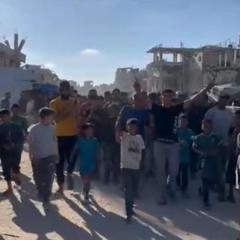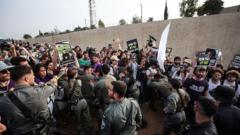After a prolonged blockade, over 90 truckloads of essential humanitarian supplies were successfully delivered to Gaza by UN teams, addressing critical shortages amid ongoing conflict and rising hunger levels.
UN Humanitarian Aid Flows into Gaza after Blockade Lifts

UN Humanitarian Aid Flows into Gaza after Blockade Lifts
In a significant development, the UN has begun distributing aid to Gaza as hostilities continue.
More than 90 trucks loaded with humanitarian aid, including flour, baby food, and medical supplies, were collected from the Kerem Shalom crossing late Wednesday night, following a three-day delay. This surge of aid marks the first significant resupply effort in Gaza after Israel eased its 11-week blockade, with pictures capturing Palestinian workers unloading flour sacks at a bakery in Khan Younis overnight.
While Israeli authorities announced the clearance of an additional 100 truckloads through Kerem Shalom, the UN criticized this as insufficient to meet the dire needs faced by Gaza’s population of 2.1 million. Humanitarian groups have raised alarms about the impending crisis of malnutrition, particularly among children, amid immense shortages and skyrocketing food prices. An assessment from the UN-supported Integrated Food Security Phase Classification (IPC) has reported that around half a million individuals could face starvation in the ensuing months.
A spokesperson from the UN confirmed that “around 90 truckloads of goods had been dispatched into Gaza” as part of this emergency operation. Footage depicting trucks moving along southern Gaza, as well as bakeries producing bread from donated flour, has been released. Antoine Renard, a senior official from the World Food Programme (WFP), underscored the dangers involved in aid collection, noting that the Israeli military required trucks to traverse routes deemed perilous by aid organizations.
At present, the value of a truck full of flour in the Gaza market is approximately $400,000 (£298,000), making the urgency of scaling up aid deliveries paramount. Renard urged for “hundreds of trucks daily” to ensure adequate supply and calm among the population. The logistics are made more challenging as aid agencies refrain from employing armed escorts for their deliveries due to safety concerns.
The situation escalated on March 2, when Israel halted all aid and commercial deliveries, launching a military stream of operations against Hamas shortly after. Israeli actions drew criticism, while the government maintains that these measures are necessary to secure the release of hostages held by Hamas.
Increased humanitarian complications arose when Prime Minister Benjamin Netanyahu announced a restricted food flow into Gaza to allow continued military operations. He justified the shift as a necessity to avoid a humanitarian crisis while maintaining operational efficacy. Reports indicate that the UN and humanitarian agencies have expressed profound objections to a controversial US-Israeli proposal that plans to bypass established UN aid routes, advocating instead for the use of a private distribution firm which would, according to critics, undermine fundamental humanitarian principles.
As these deliberations unfold amid fierce Israeli bombardments, the Hamas-run health ministry disclosed that 82 casualties were reported within the previous 24 hours. The United Nations has revealed that approximately 81% of Gaza is now under forced evacuation or in militarized "no-go" areas. Alarming statistics reveal almost 600,000 people displaced since March, with an additional surge of 161,000 forced to evacuate just within the past week.
Israel's military campaign was triggered by a cross-border assault from Hamas on October 7, which resulted in an estimated 1,200 deaths, alongside 251 reported kidnappings. A staggering 53,655 fatalities have since been recorded in Gaza amid the ongoing conflict, according to local health officials.




















